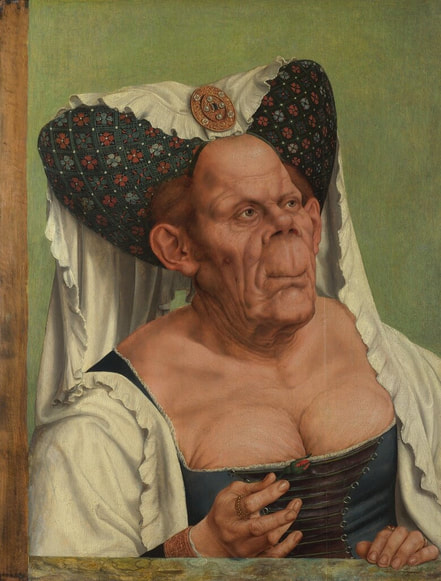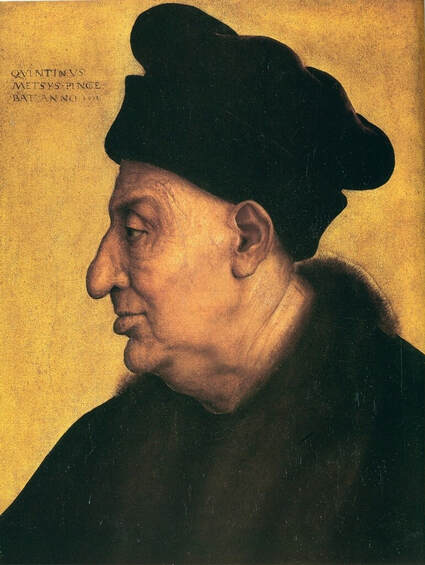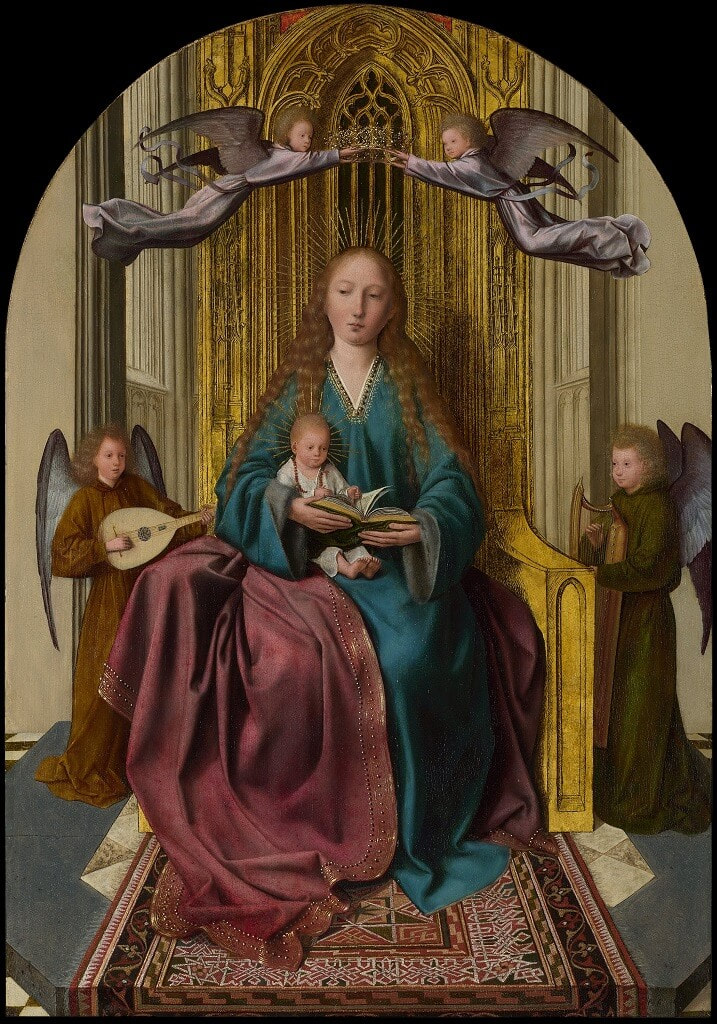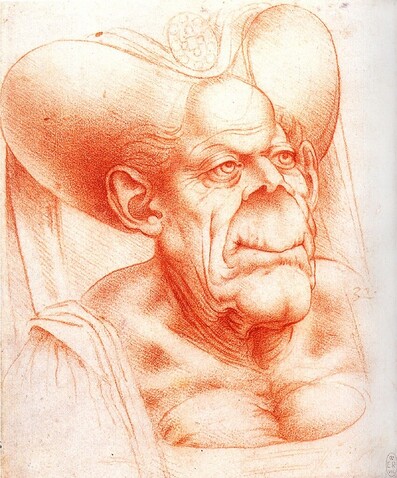|
Where? Room 27 of the National Gallery in London
When? c. 1513 Medium and size: Oil on panel, 62.4 × 45.5 cm. What do you see? It shows a portrait of a grotesque woman in luxurious clothes. Her face is somewhat malformed due to her suffering from Paget’s Disease. Massys did not try to idealize her, which is also evident by the wart on her cheek. The woman, however, is dressed in luxurious clothes, including a beautiful brooch on top of her headgear and several rings on her hands. Her outfit would have been fashionable some decades earlier, but by the time this was painted, it would be out of fashion. The painting is a pendant to the portrait of An Old Man, which Massys painted in the same year. The woman is depicted as a temptress, which Massys expressed via various clues. First, she holds a rosebud in her right hand, a flower with sexual connotations. Second, she shows a fair amount of cleavage, which would be considered quite scandalous. Third, her headgear decorated with roses, also known as a escoffion, is in the form of a heart shape, although it may simultaneously be interpreted as a pair of horns.
Backstory: The painting is popularly known as The Ugly Duchess, but it is also simply known as An Old Woman or A Grotesque Old Woman. The pendant portrait is entitled An Old Man, and so like so many pendant paintings, the couple has been separated over time. One may ask the question on whether the woman will be successful in her attempt. Massys leaves this up to the viewer. On the one hand, the old woman holds a rosebud instead of a blooming flower, suggesting that she may not be successful. But judging the gaze of the companion piece, the old man does not seem to deny her advances.
Various art historians have suggested that the painting may have been inspired by the famous book from 1511 entitled In Praise of Folly by Desiderius Erasmus. In that book Eramus writes about woman who “still wish to play the goat, industriously smear their faces with paint, never get away from the mirror, and do not hesitate to display their foul and withered breasts.” However, there is also some evidence, discussed in more detail below, suggesting that Massys already made sketches for this painting way before Eramus published his book. Paget’s Disease: For centuries, the painting was considered a satirical piece, perhaps based on some comical stock character that was popular back in the day. But with today’s scientific knowledge, we know that this woman’s face is not just an imaginary one that Massys came up with. This woman actually suffers from a rare chronic bone disease called Paget’s Disease. It’s a disease in which the body breaks down old bones and creates new bones. And these new bones can have odd shapes and are fragile. It was a more common disease in the past than today, and modern medicine can treat this disease though it cannot cure someone. In Massys’ painting, the disease manifests itself mainly in the woman’s face. Her collarbone and the bone below the eyebrow are clearly extended, they eyes are deep inside her sockets, the area between her upper lip and nose is stretched out, and her nose and nostrils are pretty wide as well. Who is Massys? Quentin Massys was an innovative Flemish artist who lived from around 1465/1466 till 1530. He was born in Leuven but was primarily active in Antwerp, where he was one of the founders of the Antwerp School of Painters. Over time, his name has been written in many different variations. His first name varies from Quinten to Kwinten to Quentin. His surname includes even more variations, including Massijs, Massys, Messijs, Messys, Matsijs, Matsys, Matsis, Metsijs, and Metsys. Massys mostly painted religious works, genre paintings, and portraits. He was innovative in terms of his compositions and use of color. Whereas his original training was in the style of the Flemish Primitives, he was one of the first Flemish and Dutch artists who actively derived inspiration from Italian Renaissance painting. Among his works are The Virgin and Child Enthroned, with Four Angels (c. 1493–1497) in the National Gallery and Ill-Matched Lovers (c. 1520–1525) in the National Gallery of Art.
Fun fact: Sometime between 1480 and 1510, Leonardo da Vinci created some drawings of grotesque skulls, one of which looks very similar to the painting by Massys. Given that the painting by Massys is dated around 1513, it would make sense to assume that Massys based his painting on the drawing by Da Vinci. It is known that Massys and Da Vinci communicated with each other and that they also shared some of their works. However, more and more art experts believe that the original design for the grotesque woman came from Massys. Furthermore, several underdrawings have been found under the painting, and it is now thought that Massys made the drawing first, which Da Vinci would then have adapted. Finally, in 1513, Massys would have turned the drawing into a panel painting.
And the painting has kept on inspiring other artists, like an illustration by John Tenniel of in Alice in Wonderland by Lewis Carroll and the 17th-century depiction of the by Wenceslaus Hollar.
Written by Eelco Kappe
References:
0 Comments
Leave a Reply. |
Categories
All
|
- Home
- Blog
-
Museums
- Alte Pinakothek
- Art Institute of Chicago
- Baltimore Museum of Art
- Barber Institute of Fine Arts
- Bargello
- Barnes Foundation
- British Museum
- Church of Sant’Anastasia
- Cleveland Museum of Art
- Courtauld Institute of Art
- Detroit Institute of Arts
- Frans Hals Museum
- Galleria Borghese
- Gallerie dell'Accademia
- Getty Museum
- Guggenheim
- Hermitage Museum
- Kunsthistorisches Museum
- Kunstmuseum Basel
- Legion of Honor Museum
- Louvre
- Mauritshuis
- Metropolitan Museum of Art
- Musee d’Orsay
- Museum of Fine Arts in Boston
- Museum of Modern Art
- National Gallery in London
- National Gallery of Art
- National Museum in Poznań
- Norton Simon Museum
- Ny Carlsberg Glyptotek
- Palace of Versailles
- Palazzo Pitti
- Palazzo Vecchio
- Petit Palais
- Philadelphia Museum of Art
- Prado
- Pushkin Museum
- Ravenna Art Museum
- Rijksmuseum
- San Diego Museum of Art
- Santa Maria delle Grazie
- St. Peter's Basilica
- Städel Museum
- Statens Museum for Kunst
- Tate Britain
- Tate Modern
- Timken Museum of Art
- Uffizi
- Vatican Museums
- Wallace Collection
-
Artists
- Altdorfer
- Anguissola
- Berlin Painter
- Bosch
- Botticelli
- Boucher
- Bronzino
- Bruegel the Elder
- Brunelleschi
- Cabanel
- Caillebotte
- Canova
- Caravaggio
- Carpeaux
- Cezanne
- Cimabue
- David
- Degas
- Delacroix
- De Maria
- Donatello
- El Greco
- Fontana
- Fra Angelico
- Fragonard
- Gauguin
- Gentileschi
- Gericault
- Gonzalez-Torres
- Goya
- Hals
- Hogarth
- Hokusai
- Ingres
- Leonardo da Vinci
- Lippi, Filippo
- Longhi, Barbara
- Lorrain
- Makovsky
- Manet
- Massys
- Matisse
- Merian
- Michelangelo
- Mochi
- Modigliani
- Monet
- Panini
- Parmigianino
- Perugino
- Picasso
- Pisanello
- Raphael
- Rembrandt
- Renoir
- Reynolds
- Rivera
- Rodin
- Rubens
- Scultori
- Seurat
- Steen
- Tintoretto
- Titian
- Toulouse-Lautrec
- Turner
- Uccello
- Van der Weyden
- Van Dyck
- Van Eyck
- Van Gogh
- Van Hemessen
- Vasari
- Velazquez
- Vermeer
- Veronese
- Vigée Le Brun
-
Locations
- Books
- About Us







